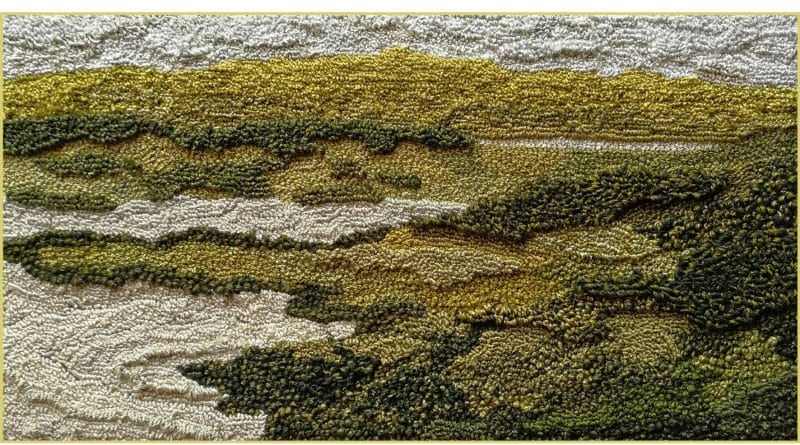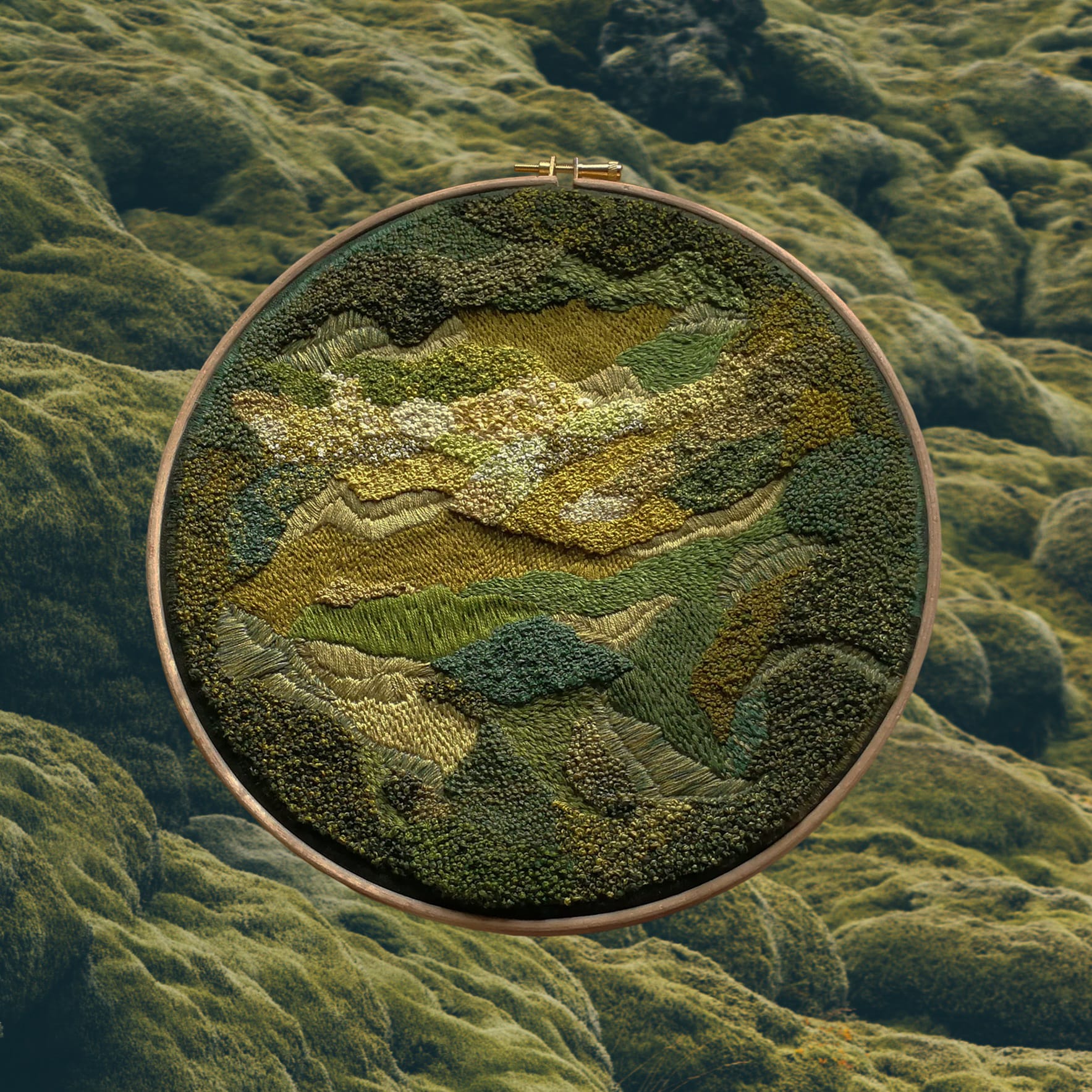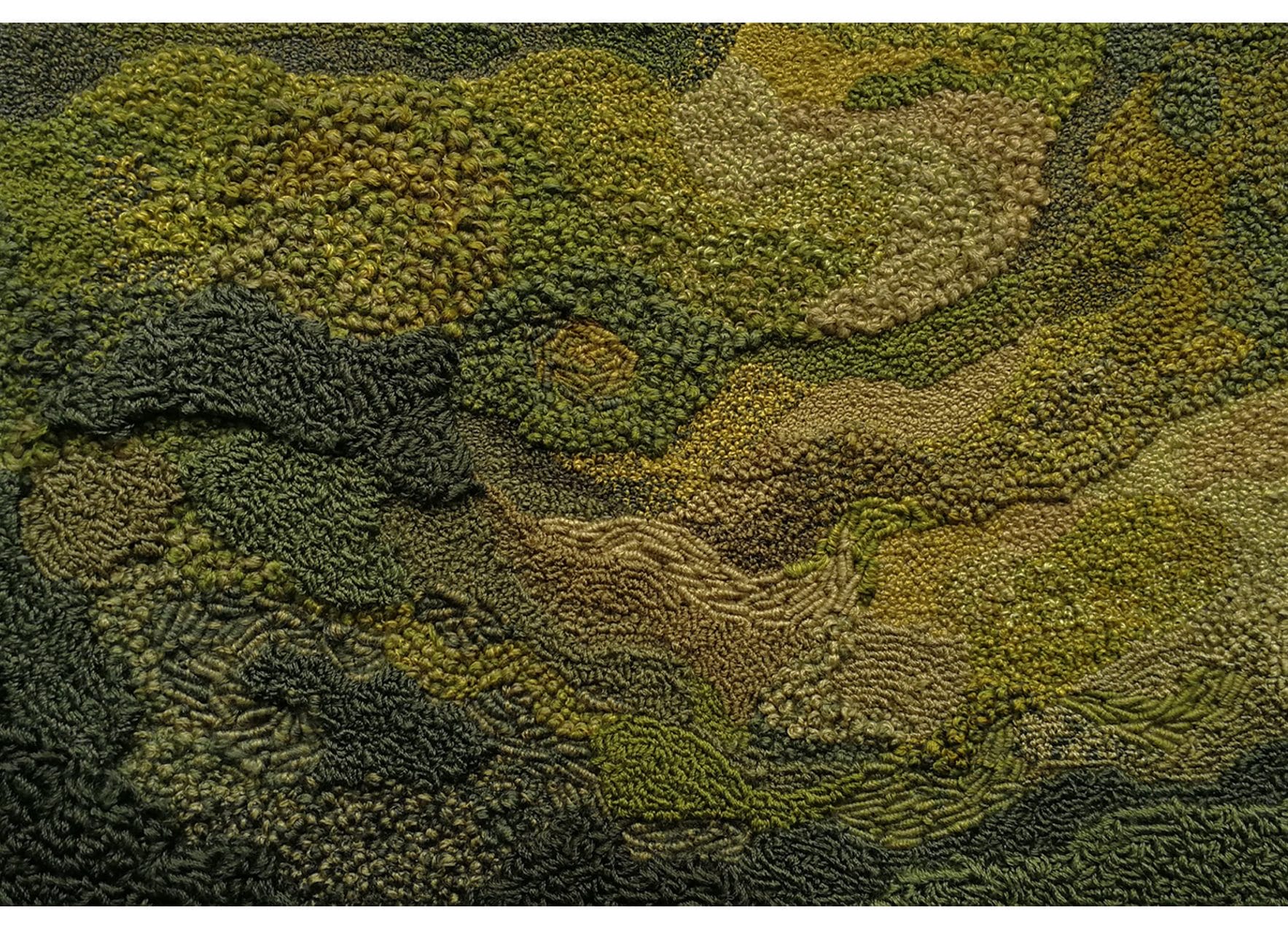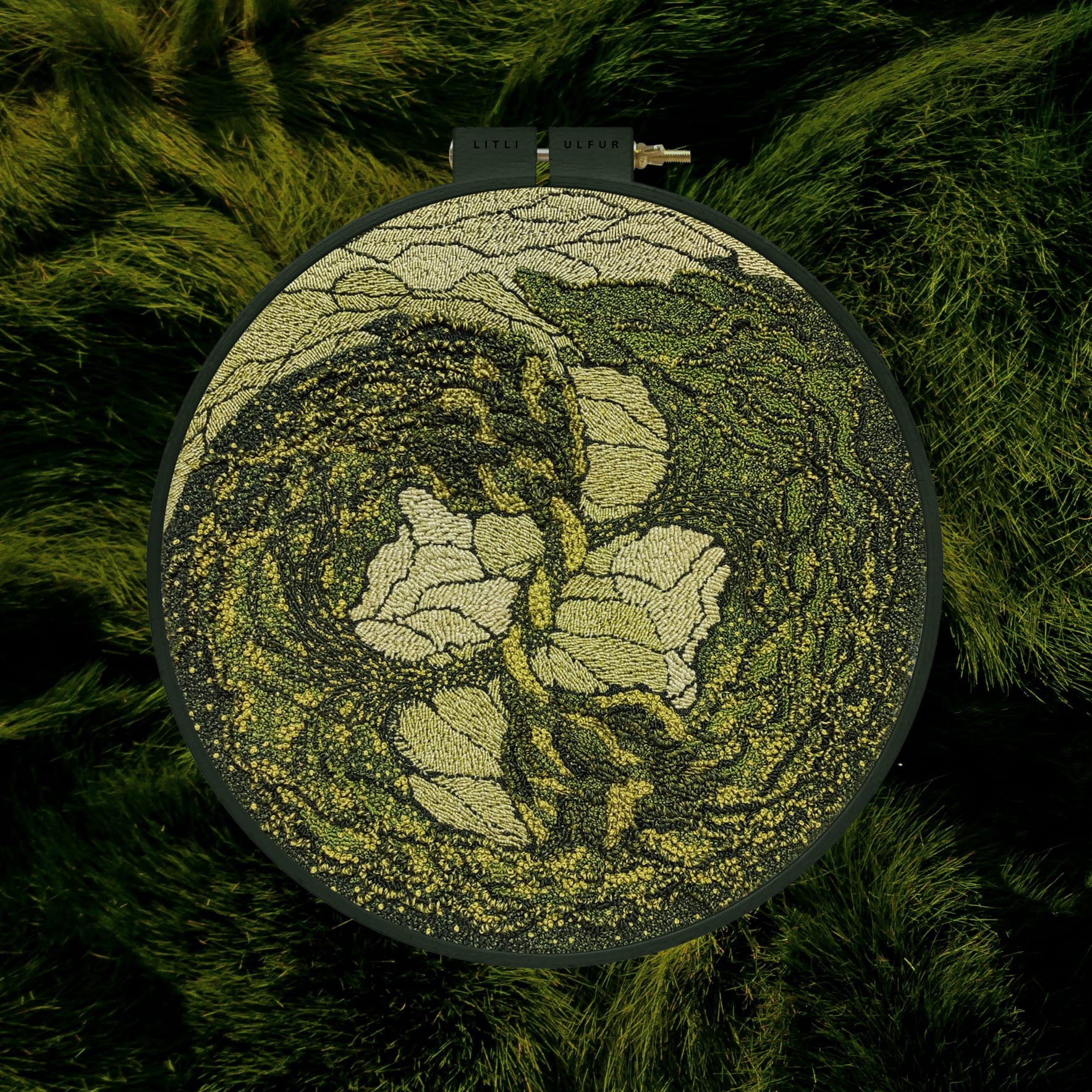INTERVIEW WITH LITLI ULFUR
All that we know about Litli Ulfur is what her artworks tell us – small pieces, realized though a refined and meticulous technique, the heart of which is a profound bond of love with nature. Therefore, it is precisely of these works that we talked about in the following interview.
Terra detail, copyright LITLI ULFUR
Nature is the inspiring muse of your works but what transpires is a deep interpenetration with it. Can you tell me how much study, observation, respect, understanding (and what else) it takes to build such a love relationship with nature?
When I was growing up I had an opportunity to commune with nature a lot. I was discovering wild, seaside, alpine forests, national parks and many more from all over the world. My home is close to the woods and I used to ride a bike there. One of the most pleasant memories I got from there are holidays spent at my aunt’s village where me and my whole family hung around together. While being there I had an impression that time ran differently. I could sense everything more deeply. I distinctly remember the intense scents spreading around, the sound of stream flowing near the house and the deep silence at night. I remember picking the full baskets of blueberries and vividness of flowers which I collected to make a bouquet on my way home. All of this is so vivid in my memories – the abundance of forests has fascinated me since I was a child. Being among so much greenness was a feast for my senses. I love nature and I am grateful that it is here.
The relationship between nature and human is deep-rooted in evolution. Nature is our home and we are part of it. This kind of relation is available to everyone, but not everyone sees it. We are currently living in a world where it is easy to forget about being rooted in nature, but it is knowing our place in it that can contribute to a sense of the meaning of life. An important factor affecting our connection with nature is a simple contact with it, during which we can become aware of the depth of our connection with it. We can then strengthen our moral and ethical concern for it and by fostering a link between nature and love.
Awake, copyright LITLI ULFUR
Awake detail, copyright LITLI ULFUR
Why did you choose embroidery as an expressive medium?
I came across many fields of art in my life – including painting, drawing, sculpture, graphic arts, industrial design. I have been discovering some of them from the early stages of life. The studies at the Academy of Fine Arts gave me further grounding as well as allowed me to learn new skills, discover new talents and also taught me some new forms of expressing myself based on knowledge and experience.
Embroidery manifested itself in many different forms in my life. Every time I saw an embroidery I wanted to try my hand at it but I didn’t have enough time due to the studies and later on, because of my job. It was till the day I decided to soak into it fully. It was in 2018 that I started to acquire the basic knowledge, watch tutorials etc. – I learnt everything by myself. In 2019 I threw myself into the embroidering, it was 7 days in a week of working late. I felt a deep connection with what I was doing. There was a huge flow in my mind and a feeling that this form of expressing myself is the most liberating for me. The curiosity of material and immaterial world pushes me to constant searching. When I’m embroidering I can reflect best what I have in my mind, my visions become real. I feel constant need for gaining more and more experience, searching for new forms and exploring the topic of embroidery fully. Embroidery is my way of communication with the world and myself.
The tide, copyright LITLI ULFUR
The tide detail, copyright LITLI ULFUR
What appears in your works is the abstraction of nature – lines, colors, texture. What emotions would you like them to convey to those who observe them?
When I realized the depth of nature’s connection with my emotional responses, it helped me to keep balance within myself. This combination is associated with lowering anxiety, creativity and calmness. This is one of the things I would like people to feel when they look at my work. Besides – I want them to feel everything that they feel individually at a given moment. Ever and again I get messages from people saying that when they look at my embroidery they feel safer, that it calms them down, or that I inspired them to have further thoughts. Awareness of such feedback makes my heart grow. Interaction with tender-minded people who try to understand my work and share their impressions with me gives me a lot of motivation for further creation. I believe that there will be as many minds as interpretations. Diversity, permission for everyone to take what they see in their own way. With every embroidery I try not to explain everything literally as I want there to be some extra space for your own interpretation / imagination.
Connection, copyright LITLI ULFUR
Connection, copyright LITLI ULFUR
Small artworks but embroidered with great precision. How long does it take on average to create one of them? How important is slowness in a world that has made of speed a value?
Creating one embroidery may take me about two months, the second one may take five – there is no rule here. The length of time devoted to one work depends on many factors- among other things, from what I experience and come across on my way, which will cause a further wave of inspiration and feelings. From the beginning of the concept in my head I’m following it completely, I am not looking for shortcuts. I need to think carefully and feel every little detail in my work before I create it physically. For example – I create a specific image in my head (base) and to introduce it to the embroidery I need to “stay” with it – so that the end result is as close as possible to the one I created in my head. It is complicated because most of the time what I see in my mind is a fusion of various senses that are difficult to capture into a physical form. For example, sound and smell are not easy to embroider, but I cannot imagine not including them as they are part of my feeling.
For me personally, slowness is crucial because only then I can stay authentic in what I do at my own pace. It’s only when I give myself permission to stop then I can see what is really going on in my mind, emotions, what I feel in my body. Ideas come to my mind on their own and I can judge clearly what is right and what is not. Creating in a hurry does not harmonize with the idea of my work. I see the rush as an illusion that distances me from the values that I want to convey in the embroidery, which causes errors that the further correction of it generates more time than if I did something in a calmer way. Speed is not and has never been a value for me, it was only a source of stress, turning in place in a pointless rush.
Do you embroider using different techniques? Which ones do you prefer and how do you choose the technique to use for each work? Do you use different techniques for a single one or do you use a single embroidery technique for each?
When taking into consideration fusion of different stimuli, impressions, emotions, approach, artwork – the creative process looks different every time. I don’t focus on one technique or on particular rules only. I use commonly known stitches (for example french knots or bullion knots) but I like to experiment with my own stitches as well – which are made without any rules. With each embroidery I follow what I feel is right at the given moment, what will be physically the closest to what I see in my imagination.
The inside, copyright LITLI ULFUR
The inside detail, copyright LITLI ULFUR
In your work THE INSIDE you detect the analogy between the rainforest and the human being. Can you explain me better?
The concept of “The inside” was created during an in-depth visual analysis of rainforests and the articles on the human nervous system, that I was studying at that time. I was struck by certain similarities between the two – some of the trees in these forests (including oaks and beeches) were confusingly similar to the structure of human neurons. Their branches and roots bent in various directions creating a huge endless network – all of this combined with the abundance of lianas, epiphytes and mosses. I have no words to describe how beautiful it looked. These insights became the main inspiration to embroider ‘The Inside’, in which I wanted to combine both themes into a whole.
In WHOLENESS, nature as a muse also becomes an integral part of the work. How and why did you come to this experimentation?
“Wholeness” is a realization of my desires to integrate what nature created into what I will create with my own hands. Half of the work is adorn with hand embroidery, the other half is graced with a beautiful natural lichen Cladonia rangiferina. Lichen is a very hardy organism, it can grow on bare rocks in conditions where plants cannot survive. It is biologically composed of two different species – the fungal cells called mycobiont and the cells of algae or bacteria called photobiont. It is pleasantly soft and springy to touch. I was delighted with its structure. Watching it in macro mode was a feast for my eyes. I must admit that nature is a total wholeness.
All the aforementioned elements influenced the fact that I decided to match lichen with my embroidery. It definitely captivated me with its structure, and in addition, it was better suited to this work because of the fact that this lichen is permanently impregnated and will not grow or overwhelm the threads. It does not require watering or contact with the sun. It only needs an air humidity of 40-60% as it draws water from the air. As long as the humidity in the room where it is located is 40-60% nothing should change and the work can be safe.
Wholeness, copyright LITLI ULFUR
Wholeness detail, copyright LITLI ULFUR
Since the advent of the pandemic you have created two works which are THE LIGHT and LOVE respectively. What is the link (if any) between the pandemic and these works? What is the meaning of two such positive works in such a difficult moment?
The choice of both topics was correlated with the emotions I was experiencing at the time, as a reflection of what I felt that I was missing, what I needed the most. When I observing what was happening among people in general – I felt that the confusion, helplessness and fear prevailed in everyone and the need for hope, any support and warmth were omnipresent. The pandemic itself was not my main concern, but it was an added element of insecurity and general anxiety.
I was creating the “The light” embroidery while experiencing the toughest emotions I have ever felt in my life because my mother was diagnosed with cancer at that time. This moment – to put it simply – made my world fall apart. My body and psyche weakened to the limit back then. What I needed then was the hope that everything would be alright someday, that this nightmare would go away and that my mother would recover. Therefore, the main inspiration for “The Light” embroidery was hope. Hope for appearing of a light that would show us a safe place in the present, harsh circumstances around the world. From the very beginning, this embroidery was to refer to a soft, cosy nest which center is shrouded in light.
The embroidery “Love” is and always will be particularly unique for me, because while creating it a lot of basic changes were taking place in my heart – from fighting difficulties to the touching moment when my mother overcame cancer. The feeling of love and gratitude were intertwined with each other and everything was accompanied by hope without which I would not be able to carry such a baggage. Facing all of this, I could understand and feel what is really the most important in my life. I have learned that love is not a feeling to be looked for – it just exists. And while I’m alive, I want to experience it directly through being here and now. “Love” is my personal vision of love. I dedicate it to everyone, with a great honour for my mother.
Creating “The light” and “Love” gave me a shelter. It allowed me to organize the thoughts in my head and not to identify myself with the dark scenarios that haunted me. While I was embroidering, I was able to silently observe the actions of my mind, trying not to judge and not to identify myself with the thoughts which with such strong emotions were often distorted. I needed to overcome the immense fear that stood in the way to accept love and truth. It was just me and the embroidery, I could gather strength to be able to support others and myself then. I could share what I feel with the world in my own way.
Are your works for sale?
So far I don’t sell any of my works. I’m now focusing on creative work, but I don’t exclude that someday I will feel that this is the right moment to release them into the world – I must feel really ready for this. I don’t know when this time comes but I will put it in my Instagram bio or in the main post when I feel ready.
Love, copyright LITLI ULFUR
Love detail, copyright LITLI ULFUR






